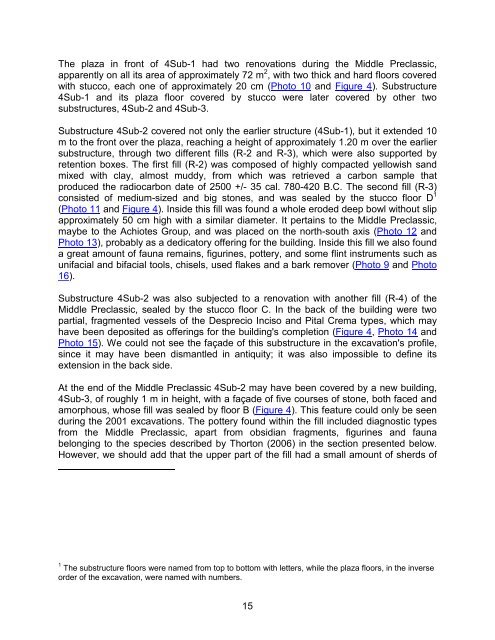Buenavista-Nuevo San José, Petén, Guatemala: Another ... - Famsi
Buenavista-Nuevo San José, Petén, Guatemala: Another ... - Famsi
Buenavista-Nuevo San José, Petén, Guatemala: Another ... - Famsi
Create successful ePaper yourself
Turn your PDF publications into a flip-book with our unique Google optimized e-Paper software.
The plaza in front of 4Sub-1 had two renovations during the Middle Preclassic,<br />
apparently on all its area of approximately 72 m 2 , with two thick and hard floors covered<br />
with stucco, each one of approximately 20 cm (Photo 10 and Figure 4). Substructure<br />
4Sub-1 and its plaza floor covered by stucco were later covered by other two<br />
substructures, 4Sub-2 and 4Sub-3.<br />
Substructure 4Sub-2 covered not only the earlier structure (4Sub-1), but it extended 10<br />
m to the front over the plaza, reaching a height of approximately 1.20 m over the earlier<br />
substructure, through two different fills (R-2 and R-3), which were also supported by<br />
retention boxes. The first fill (R-2) was composed of highly compacted yellowish sand<br />
mixed with clay, almost muddy, from which was retrieved a carbon sample that<br />
produced the radiocarbon date of 2500 +/- 35 cal. 780-420 B.C. The second fill (R-3)<br />
consisted of medium-sized and big stones, and was sealed by the stucco floor D 1<br />
(Photo 11 and Figure 4). Inside this fill was found a whole eroded deep bowl without slip<br />
approximately 50 cm high with a similar diameter. It pertains to the Middle Preclassic,<br />
maybe to the Achiotes Group, and was placed on the north-south axis (Photo 12 and<br />
Photo 13), probably as a dedicatory offering for the building. Inside this fill we also found<br />
a great amount of fauna remains, figurines, pottery, and some flint instruments such as<br />
unifacial and bifacial tools, chisels, used flakes and a bark remover (Photo 9 and Photo<br />
16).<br />
Substructure 4Sub-2 was also subjected to a renovation with another fill (R-4) of the<br />
Middle Preclassic, sealed by the stucco floor C. In the back of the building were two<br />
partial, fragmented vessels of the Desprecio Inciso and Pital Crema types, which may<br />
have been deposited as offerings for the building's completion (Figure 4, Photo 14 and<br />
Photo 15). We could not see the façade of this substructure in the excavation's profile,<br />
since it may have been dismantled in antiquity; it was also impossible to define its<br />
extension in the back side.<br />
At the end of the Middle Preclassic 4Sub-2 may have been covered by a new building,<br />
4Sub-3, of roughly 1 m in height, with a façade of five courses of stone, both faced and<br />
amorphous, whose fill was sealed by floor B (Figure 4). This feature could only be seen<br />
during the 2001 excavations. The pottery found within the fill included diagnostic types<br />
from the Middle Preclassic, apart from obsidian fragments, figurines and fauna<br />
belonging to the species described by Thorton (2006) in the section presented below.<br />
However, we should add that the upper part of the fill had a small amount of sherds of<br />
1 The substructure floors were named from top to bottom with letters, while the plaza floors, in the inverse<br />
order of the excavation, were named with numbers.<br />
15
















